VVAM Newsletter 97 – 2005
AGM
You are invited to attend the 25th AGM / Annual Meeting of the Society of Friends of the Airborne Museum on Saturday 2 April 2005. The meeting will be held in the Concertzaal, Rozensteeg 3, Ooster- beek, starting at 14.00 hours.
The agenda is as follows:
1 Opening
2 Minutes of the AGM of 3 April 2004
3 General report 2004
4 Financial report 2004
5 Budget for 2005
6 Audit Committee report
7 Alteration to Statutes
8 Board of Management elections
9 Appointment of reserve member to the Audit Committee
10 Questions
11 Closure of meeting
Points 3 and 4: you will be given the General and Financial reports on arrival, and the Audit Commit tee report will be available for perusal at the hall entrance half an hour before the opening of the meeting. You can also request copies of the General and Financial reports by writing to the Treasurer, Mr F. Miedema, Woudstralaan 24, 6862 XE Oosterbeek, enclosing a stamped (70 Eurocent stamp), selfaddressed envelope.
Point 7: Frits Miedema has reached the end of his term of office but is prepared to stand for re-elec tion.
Members may propose alternative candidates in accordance with article 8 of the Statutes. Written notification to this effect should be sent to the sec retary of the SPAM (c/o Airborne Museum, Ooster beek) at least ten days before the meeting. This should be signed by at least ten members and accompanied by a declaration of willingness to serve from the proposed candidate, who must be a member of the society and of age.
After the AGM a number of films will be shown about the liberation of the Netherlands, which took place sixty years ago.
The jubilee and other events in 2005
This Newsletter includes a folder containing a list of the most important Airborne’ events in 2005. The programme for the 25th Jubilee of our society on 21 May this year will be sent to you shortly.
Wanted: ‘Webmaster’
With this Newsletter the board would like to get in touch with someone who would be prepared to take on the development and updating of the Society of Friends of the Airborne Museum’s website.
This has mainly to do with the content. Together with the Newsletter, the website has to become the Society’s ‘shop window’. Eventually it is intended that current news will be featured increasingly on the web site. The present newsletter can then be used more for subjects of ‘documentary’ value. If you are interested in becoming the webmaster of the SFAM’s website, please contact the secretary of the SFAM board, Ivar Goedings, e-mail: goedings@van-lotringen.nl
Statutes
As you might have been following in the media, the SFAM has been involved with the recent developments at Dreyenseweg. Late last year all the trees lining this beautiful lane, which runs through the municipalities of both Arnhem and Renkum from Amsterdamseweg to Oosterbeek-Hoog Station, were
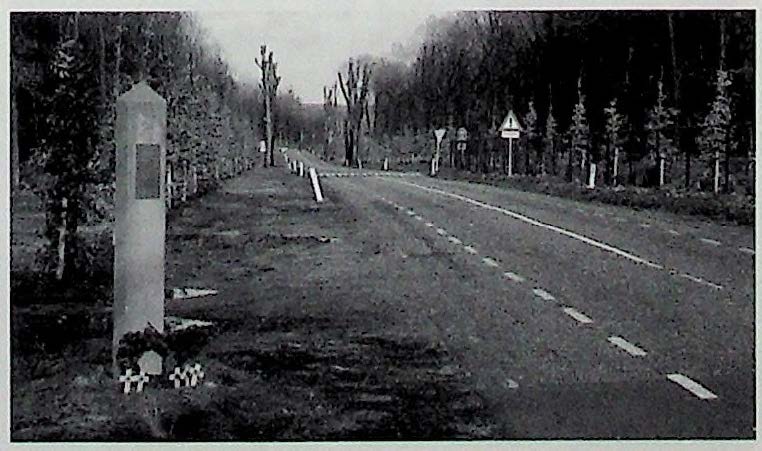
13 February 2005. The Jelling of the trees along Dreyen seweg to the north of Oosterbeek at the end of last year has given the lane a very bare look. Meanwhile, saplings have been planted. On the left is the monument to 156 Battalion, The Parachute Regiment.
felled. These trees had a special significance to the Battle of Arnhem. Fierce fighting took place at and near Dreyenseweg in September 1944, and many a combatant was killed within sight of this lane as well as under the very trees. Numerous trees were riddled with bullets and shrapnel. Of course, I would like to point out that the SFAM has absolutely noth-ing against the laying of a new cycle path along the eastern side of the road, but the felling of the trees was a separate issue. The SFAM also share the view that trees in a really dangerous state should be felled. However, from the report of the expert brought in by Arnhem council it appears that most of the trees were perfectly safe.
At a certain point the SFAM was forced to accept that Arnhem council had nevertheless issued plan ning permission, which included a permit for felling the trees along Dreyenseweg. The SFAM and a num ber of members filed an objection to this permit. When, in mid-October 2004, it became evident that Arnhem council was not prepared to postpone the tree felling in spite of urgent requests not to, and in spite of the procedure that was in progress, the SFAM sought a so-called ‘provisional relief via the Arnhem Court. In this manner we hoped to bring about deferment of the felling by the council until the result of the complaint procedure was known. However, despite the link between the trees along the lane and the Battle of Arnhem, the court found that we, as SFAM, could not be regarded as an inter ested party and our request was turned down.
Our statutes were then carefully looked into which showed emphatically that our interest lies princi pally in the provision of support and financial assis tance to the Airborne Museum. Standing up for interests outside of those mentioned above – even if they are related to the Battle of Arnhem – is there fore outside our remit. The SFAM board then decid ed to raise the issue of a change to the statutes at the forthcoming AGM. This change must enable the SFAM to make its voice heard on matters directly related to ‘the Battle of Arnhem’. One example which immediately springs to mind concerns future developments involving Park Hartenstein.
The board’s proposal is to modify the statutes to include the point that the SFAM’s objectives will also incorporate: ‘the protection of the interests and rights – in the widest sense – related c.q. linked to the Battle of Arnhem. If necessary, by resorting to legal pro cedures.’
A transcript of the statutes concept is available for perusal at the Airborne Museum counter.
(Ivar Goedings, secretary)
‘Arnhem Weekend’ 2005
The ‘Arnhem Weekend’ for UK members of the SFAM has been fixed for 17,18 and 19 June 2005. The provisional programme is as follows.
On Friday 17 June a walk through Oosterbeek will be made during which the stories behind a number of photos taken at the time of, or after, the Battle of Arnhem will be told. We shall also visit the monu ment commemorating ‘Operation Berlin’, located on the flood plains behind the Old Church. In the evening there will be a get-together in the Airborne Museum where British and Dutch members can meet one another.
Saturday 18 June is given over entirely to the 1st Parachute Brigade, with emphasis on the actions that took place in the area stretching from the viaduct near Oosterbeek-Laag station to the bridge in Arnhem. David van Buggenum will explain the part played by B Company, 2nd Parachute Battalion. ‘Den Brink’, the highest feature in the area, will also be visited. Other subjects covered will be the fate of the Gronert twins who were killed within minutes of each other near Oosterbeek-Laag station, the men of the South Staffordshire battalion in west Amhem, Captain Killick’s patrol in Weerdjesstraat (in which the story of the weaponry he carried will be told for the first time), and the actions of the 1st and 3rd Parachute Battalions. We end the day at the bridge in Amhem, where sites visited will include a selection of places where German photographers took pictures during the fighting.
On Sunday 19 June we travel first to the area around Nijmegen, taking in Groesbeek, Landing Zone ‘N’ and the war cemetery at Jonkerbos. The trip will then continue to the region between Nijmegen and Arnhem, where among the places looked at will be the spot where the Valburg Conference was held. After this we shall focus on the actions of the Guards and the 43rd Wessex Division. The landing zone of the Polish Parachute Brigade at Driel will then be visited.
Prior to the excursion all participants are strongly advised to read David van Buggenum’s book, ‘B Company Arrived’. I still have a few copies left, so you can order one from me if you wish. Supplies in the Netherlands are almost exhausted too, so hurry up and buy a copy before this excellent work is sold out. Till June 2005!
(Niall Cherry)
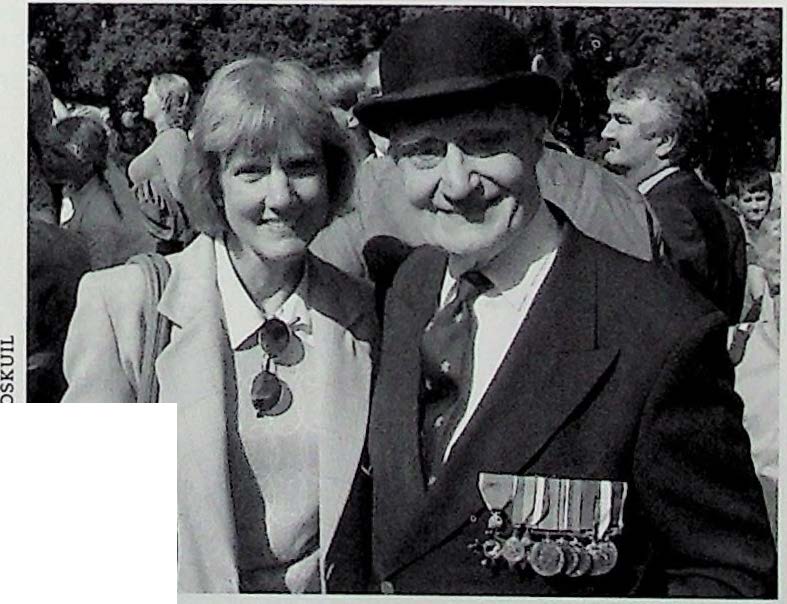
A lookback at September 2004. There was one veteran wearing a traditional bowler hat instead of his beret at the memorial service at the Airborne Cemetery on the 19th. He was Society member Major (retd.) Douglas Goddard, co author of the book ‘112th (Wessex) Field Regiment RA, TA., 1938-1946’. Units of this regiment gave artillery support to the British troops in Oosterbeek from 23 September 1944 onwards. Major Goddard was accompanied by his daughter Tina during the commemoration.
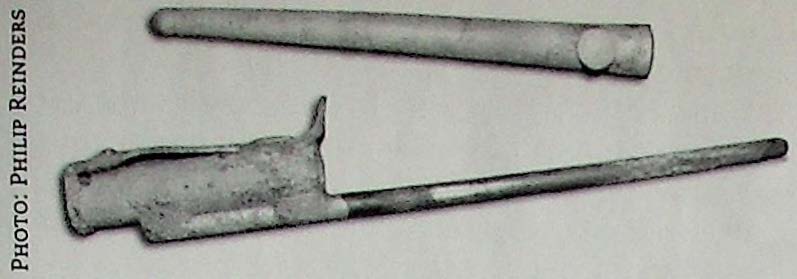
The unusual Stengun bayonet recently found on Ginkel Heath at the place cohere C Company of the 7th Battalion, The King’s Own Scottish Borderers was dug in on 17 and 18 September 1944.
Rare Stengun bayonet excavated
Philip Reinders of the ‘Arnhem Battle Research Group’, who regularly combs the former battlefields around Arnhem with a metal detector, recently unearthed a very unusual Stengun bayonet near Ginkel Heath. It is the type that is officially known as ‘Bayonet Machine Carbine Mark I’ which only fits the Stengun Mark II, the one with the open, metal butt. In 1944 the British airborne forces were mainly equipped with the more modem Sten Mark V, which had a wooden butt and two wooden handgrips. But apparently some troops were still using the old Mark II. The bayonet was found near Ginkel Heath at the spot where C Company of the 7th Battalion, The King’s Own Scottish Borderers was positioned on 17 and 18 September 1944
True enough, this type of bayonet was produced in great numbers during the war but the majority were never issued. They were destroyed some time later, so this type is really very rare, and is often ‘faked’. The Airborne Museum has an original example.
‘Green On!’
The book ‘Green On!’ by member Arie-Jan van Hees was presented in Oosterbeek library on 17 Septem ber 2004. As the sub-title, ‘A detailed survey of the British parachute re-supply sorties during operation “Market Garden” 18 – 25 September 1944’, suggests, the publication gives a detailed survey of the re supply drops during the Battle of Arnhem. The title, which was also used for the exhibition in the Airborne Museum in 2000, is taken from the order that was given to drop the panniers and containers when the green light in the aircraft came on. However, the book is not restricted to just the re supply facet. ‘Air Support’ is also dealt with very thoroughly. In common with his previous book, ‘Higs and Gliders to Arnhem’ this publication is also characterized by its enormous quantity of informa tion, accompanied by many personal accounts. The day to day flights from all the airfields are system atically described, starting with the ‘Air Support’. The book is rounded off with chapters on personal experiences, the escapes, the prisoners of war, an evaluation and an extensive register. His chosen structure does not make the book easy to read; it is more a good reference work. And that is obviously the author’s intention.
Some sections of the book have been used by Arie- Jan before. The history of the US Air Support Teams and the Radar Unit were covered extensively in ‘Tugs and Gliders to Arnhem’. It would appear that the few new details available in the Airborne Museum could not be used. The report by the American Lieutenant Bruce Davis has also to be taken as well known. And when we come across the meagre sources on these units again in the ‘Personal Stories’ chapter, perhaps that is going a bit too far. This in no way diminishes the admiration one must have for the number of details and photos the author has obtained. A loose index simplifies the search for information and, as one would expect from him, the finished article is excellent. The font used is indeed small, but legible.
The photo prints are generally good with a few exceptions, for example the photo on page 310 that was taken in front of the Hartenstein. The source acknowledgement of the photographs is an im provement on the previous book.
‘Green On!’ is in English, comprises 379 pages, and is published by the author himself (ISBN 90-806808-2-6). It is a must for any library about Market Garden.
The book can be ordered direct from A.J. van Hees, Courtpendu 7, 6245 PE Eijsden (e-mail ariejan@mar- ketgarden.com) for € 50, including p & p (€ 55 for the UK). It is for sale, at higher cost, in the Airborne Museum and local bookshops in Oosterbeek.
(Wybo Boersma)
The Thirteenth Platoon
A book with the above title was published in September 2004, and the story of how it came into being is very unusual. In 1998 the author, Dutch journalist Haks Walburgh Schmidt, assisted with the setting-up of the exhibition in the Airborne Museum about the British and Polish servicemen who became German POWs after the Battle of Arnhem. He wrote a special museum newspaper for the exhibition entitled ‘Bevrijders achter Prikkel- draad’ (Liberators behind barbed-wire). During his preparatory work for the paper, Haks read an account by Bill Williams, a sergeant in the Glider Pilot Regiment in 1944. On 18 September 1944 Bill flew Horsa glider number 166 to Arnhem, landing just west of Wolfheze. His address was known and Haks got in touch with him to find out more about his adventures. He also wanted to know which unit Bill had carried in his glider. However, Bill was unable to provide much information on that point. Haks therefore decided to start his own investiga tion into what became of the men in Horsa 166.
Archive photos showed that they must have belonged to 13 Platoon, 1st Battalion, The Border Regiment, 25 men in all. Via letters, telephone calls, newspaper appeals and, especially, the internet he tried to trace the men in question.
In the end this quest was to take four years. The result is summed up in this fascinating four-part book. The following are described in sequence: the experiences of Bill Williams, the author’s search for the men who were carried in Horsa 166,13 Platoon’s actions during the Battle of Arnhem, and the fate of the soldiers after September 1944. What makes the book so unusual is that the human aspect and per sonal experiences form the focal point. The book is aptly subtitled ‘Levensverhalen rond zweefvliegtuig Horsa 166’ (Life stories around Horsa glider 166). Highly recommended!
‘Het Dertiende Peloton’, by Haks Walburgh Schmidt (ISBN 90-5911-340-3), comprises 266 pages, and is illustrated with maps and many photographs. It is published by ASPEKT in Soesterberg. Price € 24,95.
Schoolchild in wartime
There are numerous publications written by people after World War II describing the experiences of their early years during the 1940-1945 period. But there are very few young Dutch folk who kept a diary dur ing the war years, and very few have ever been pub lished. At last, 60 years on, such a diary became available to the reading public in September 2004. It is the story of Arnhem schoolboy Felix Valk who, from early August 1943 until the end of April 1945, recorded the events he experienced in two school exercise books. After Felix Valk’s death in 1999, his sister Else came across his writings while going through his estate. The diaries came into the hands of emeritus Professor in Developmental Psychology Dolf Kohnstamm, who became so fascinated by what he read that he decided, in consultation with the family, to edit the diaries and publish them.
Felix Valk, born in 1929, lived with his family in Bovenbrugstraat 7 in Arnhem. He attended the Stedelijk Gymnasium (City Grammar School) in the city. The diary shows that, at first, he sees the war as an adventure, doubtless in common with many lads of his age. He notes down any aircraft that fly over, collects dropped pamphlets and goes in search of crashed aeroplanes with his friends. But as time passes the diary takes on a more serious note.
When the Allied airborne landings begin near Arnhem on Sunday 17 September 1944, he goes to stay with the Roell family in Schaarsbergen. During the period of the Battle of Arnhem his inquisitive and enterprising nature lead to the due adventures, which he describes meticulously. Especially the dropping of supplies by British aircraft near Warns- born engages his interest.
On 6 October 1944 he leaves Schaarsbergen in order to move to the North Veluwe with his family. He records all the events of this period, as well as the liberation by the Canadians in April 1945, with a great eye for details.
This book makes very easy reading and is of great interest to adults, as well as being recommended to younger folk.
‘Scholier in Oorlogstijd 1943-1945, Arnhem-Veluwe’, by Felix Valk, is published by Uitgeverij Kontrast in Oosterbeek. The edition (ISBN 9075665679) numbers 96 pages, and is illustrated with many photos and maps from the original diary. The book costs € 13,95.
Co-operation between Airborne Museum and Gelderland 1940-1945
The board of directors of the Airborne Museum and the initiators of the website Gelderland 1940-1945 (http://www.gelderlandl940-1945.nl/nl/) have re cently decided to join forces: the museum is to par ticipate in the project.
The website is the product of a joint venture involv ing the Gelderland Library – a department of Amhem Library – and the Gelders Archives, both located in Arnhem. The aim of this site is to familiarise those interested in the Second World War with the con tents of the archives and collections managed by the associated bodies.
Within the framework of the discussion between archive, library and museum, the first step was the compilation of an overview of the files available in the Hartenstein (library, documentation, newspa pers, photos, films, audio tapes etc) which will be included in the museum’s collection plan, shortly due for completion. With the aid of this plan, it will then be possible to establish how the co-operation with respect to the website will be given shape.
The museum’s documentary collection is principal ly concerned with the hostilities in September 1944, within the overall picture of operation Market Garden. The emphasis of this material is on the area around Arnhem, Driel, Ede and Oosterbeek.
Expectations are that the first collection will be accessible on the internet within a foreseeable timeframe. Anyone wishing to get a preview of the above-mentioned collections will need to make a prior appointment. For the record: the above refers to the so-called documentary collection. The per manent museum collection (uniforms, weapons, dioramas etc) can of course be seen in the Harten stein during normal opening times.
Information about the museum can be found on its own website (www.airbornemuseum.nl).
(Geert Maassen)
COLOPHON
The Newsletter is a publication of the Society of Friends of the Airborne Museum Oosterbeek (SFAM) and appears four times per year. The objective is to promote the Airborne Museum, the SFAM and the history of the Battle of Arnhem.
Editors: drs. R.P.G.A. Voskuil and G.H. Maassen jr. Editorship address: Jan van Riebeeckweg 39, 6861 BD Oosterbeek; e-mail: vvam@planet.nl Coordination sending, archiving and distribution of back numbers: Chris van Roekel, Oosterbeek.
English translation: Cathrien and Peter Clark.
Design: Hildebrand DTP, Wageningen.
Print: Drukkerij Verweij Wageningen BV.
SFAM representative in the U.K.: Niall Cherry, 3 Church Road, Warton, Lancs PR4 1BD, tel. 01772 632764; e-mail: niall.cherry@baesystems.com Airborne Museum ‘Hartenstein’ address:
Utrechtseweg 232, 6862 AZ Oosterbeek, telephone 00 31 26 3337710;
e-mail: info@airbornemuseum.com
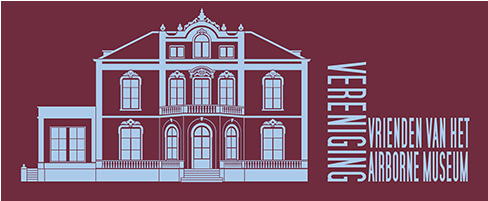
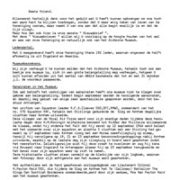
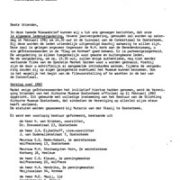
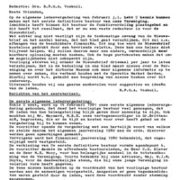
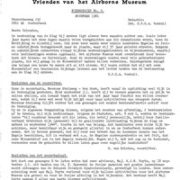
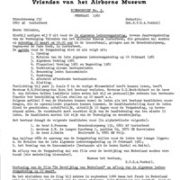
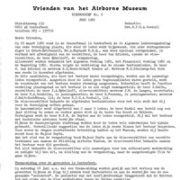
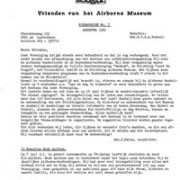
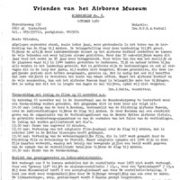
Plaats een Reactie
Vraag of reactie?Laat hier uw reactie achter.